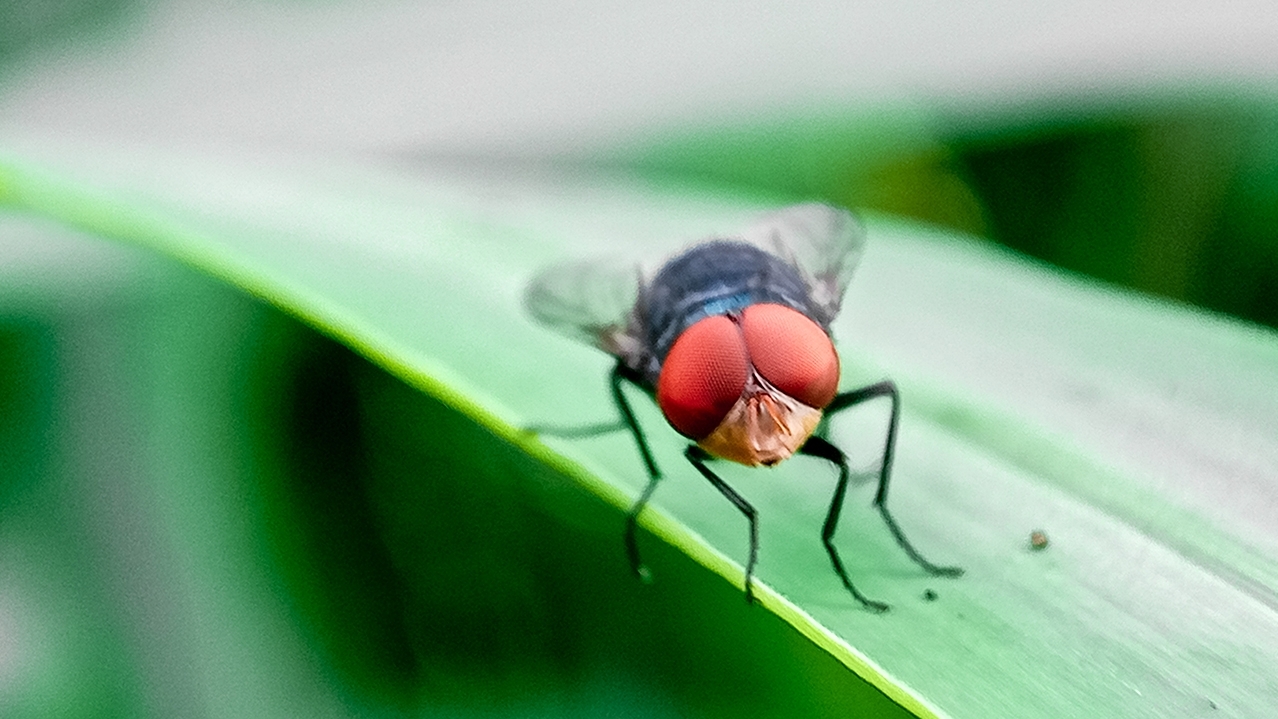New World Screwworm

New World screwworm (NWS, Cochliomyia hominivorax) is a devastating pest. When NWS fly larvae (maggots) burrow into the flesh of a living animal, they cause serious, often deadly damage to the animal. NWS can infest livestock, pets, wildlife, occasionally birds, and in rare cases, people.
NWS is endemic in Cuba, Haiti, the Dominican Republic, and countries in South America, with cases spreading north to Costa Rica, Nicaragua, Honduras, Guatemala, Belize, El Salvador, and Mexico. Although USDA eradicated NWS from the United States in 1966 using sterile insect technique, there is a constant risk of re-introduction into the United States. To prevent the northward movement of this pest from South America to NWS-free areas in Central and North America, APHIS collaborates with Panama to maintain a barrier zone in eastern Panama. The cornerstone of this collaboration is the Panama-United States Commission for the Eradication and Prevention of Screwworm (COPEG). Through COPEG, we release sterile male screwworm flies in the Darien Province of eastern Panama to create a biological barrier.
NWS Outbreak in Central America and Mexico
APHIS is partnering with other USDA agencies, the U.S. Department of State, the Food and Agriculture Organization of the United Nations, and affected countries to respond to an outbreak of NWS in Central America and Mexico.
The name screwworm refers to the maggots' feeding behavior as they burrow (screw) into the wound, feeding as they go like a screw being driven into wood. Maggots cause extensive damage by tearing at the hosts’ tissue with sharp mouth hooks. The wound can become larger and deepen as more maggots hatch and feed on living tissue. As a result, NWS can cause serious, often deadly damage to the animal.
Adult screwworm flies are about the size of a common housefly (or slightly larger). They have orange eyes, a metallic blue or green body, and three dark stripes along their backs.
Report mammals and birds with the following signs:
- Irritated behavior
- Head shaking
- The smell of decay
- Presence of fly larvae (maggots) in wounds
Learn More
- Pest Alert | New World Screwworm (212.06 KB)(also in Spanish (221.68 KB))
- Brochure | New World Screwworm: What You Need To Know (480.86 KB) (also in Spanish (2.06 MB))
- Poster | Screwworm: An International Threat to Human and Animal Health (958.86 KB)
- Pest Card | New World Screwworm (874.64 KB)
The best way to keep screwworm out of this country is to prevent introductions. NWS can infest mammals, including people, and birds. Here are steps you can take to avoid infestation:
- Be alert for NWS symptoms in pets and livestock.
- Ensure that pets traveling internationally are inspected for screwworm.
- Check your vehicle for screwworm flies if you are in an NWS-infested area.
If you think you have found a screwworm, report it immediately to your State animal health official and APHIS office. This will allow APHIS and partner agencies to respond quickly and remove the screwworms before a population becomes established.
Eradicating NWS is only possible through sterile insect technique (237.54 KB). With this method, sterile flies are released into an area where a known population has become established. The sterile male screwworm flies mate with fertile female screwworm flies, causing the population of screwworm flies to decrease until it eventually dies out.
Animals infested with NWS should be treated according to the recommendations of their veterinarian.
View List of Pesticides to Potentially Use Against New World Screwworm (162.66 KB)
People who suspect they are infested with NWS should seek immediate medical treatment following the Centers for Disease Control and Prevention (CDC) guidelines. For information on how screwworms affect people or to report human disease, visit CDC at About New World Screwworm Myiasis and Clinical Overview of New World Screwworm Myiasis.
Report Signs of Animal Disease
Producers or owners who suspect an animal disease should contact their veterinarian to evaluate the animal or herd. Find an accredited veterinarian.
Animal health professionals (veterinarians; diagnostic laboratories; public health, zoo, or wildlife personnel; and others) report diagnosed or suspected cases of nationally listed reportable animal diseases to APHIS Area Veterinarians in Charge and to the State animal health official as applicable under State reporting regulations.
Controlling New World Screwworm
Standard Operating Procedure for Possible NWS Detection
- APHIS Standard Operating Procedure for Possible Detection of NWS in Animals (253.53 KB)
- APHIS Standard Operating Procedure for Possible Detections of NWS in Dogs (327.17 KB)
National Veterinary Accreditation Program Training
Factsheets
- New World Screwworm: Be Aware and Prepare (626.46 KB)
This report summarizes historical economic impact estimates of NWS in the United States, costs associated with NWS infestation, and the potential economic impact of NWS in 2024.
New World Screwworm Eradication Programs, by Start Date (776.15 KB)
Time-Lapse Video of the 2016–2017 NWS Investigations in the United States
Time-Lapse Video of the 2016–2017 NWS Investigations in Florida
Investigation into Introduction of New World Screwworm into Florida Keys, 2016 (714.19 KB)
Final Report for the APHIS Veterinary Services Response to the 2016–2017 Outbreak of NWS in Florida (2.9 MB)


